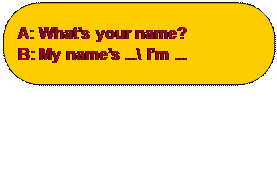Unit 1 My name's Gina(第3课时)
Section A Grammar Focus-3c P3
教学目标:
一、功能:Learn to talk about names.
二、词汇和常用表达:Learn and use “what” to ask others’ names and introduce themselves.
三、学习策略:Guide the students to master the speaking skills and communicative competence.
四、文化知识:Guide the students to greet others and introduce themselves, and know more about others.
教学过程
Step I. Teaching Aims:
Tell the Ss they are going to learn Unit 1 Grammar Focus -3c.
Step II. Review

1.Begin with a short game:
T: I’m your English teacher, do you know my name?
Ss: Yes.
T: My name’s Liu Qian. What’s your name?
S1: (Ask a student to answer) My name’s…
T: What’s your name?( Ask another student)
S2: (Help the student answer) I’m…
Ask them to practice the dialogue in pairs.
A: What’s your name?
B: My name’s…\I’m…
2.
T: (Ask a boy)Are you Chen Yang?
S3: Yes, I am.
T: (Ask another boy) Are you Chen Yang?
S4: No, I’m not. 
T: (Point at Chen Yang and ask other students) Is he Chen Yang?
SS: Yes, he is.
T: What’s his name?
Ss: His name’s Chen Yang.\He’s Chen Yang\ Chen Yang.
T: (Point at another boy) Is he Chen Yang?
Ss: No, he isn’t.
Ask them to practice in pairs.
The same method to practice :
What’s her name?
Her name’s Wang Ling. \ She’s Wang Ling.\ Wang Ling.
Is she Wang Ling?
Yes, she is.\No,she isn’t
[操作说明]将班里学生分成几个小组,要兼顾不同层次的学生。首先小游戏导入,询问对方的姓名,教授学生回答的几种方式。接着询问他人姓名以及回答方式,并且拉出一般疑问句。教师要对学生进行对话朗读检查,评出优劣。
板书:
(设计意图:通过情景导入询问姓名的对话,包括询问对方姓名,询问他人姓名,以及介绍自己和他人。在板书部分,把句子按功能进行分类排放,并让学生小组内操练对话。)
Step III. Grammar focus
1.Ask the Ss to read the Grammar focus
2.Then, ask the Ss to summary the different usages of adverb be by comparing the sentences on the Bb.
3.翻译探究:
(1)My name’s Gina.
my意为“ ”。 形容词行物主代词具有形容词的性质,一般位于 前作定语,表明该名词所表示的人或物是
。形容词性物主代词后面必须跟一个 。如:
①我叫麦克。
②那是她的香蕉。
③This is (我的)pen.
④The boy is ten years old. (他的名字)is Jim.
(设计意图:通过这几个练习让学生充分运用形容词性物主代词,从而本节课的重难点得到强化和落实。)
(2).What’s your name?
这是询问对方 的句型。答语是“My name’s…”或是 “I’m…”,也可以直接说出自己的名字。如:
①-- What’s your name?
-- name is Tony.
②-- What’s the girl’s name?
-- name is Jenny.
(3).此栏是缩略形式,其规律是’m 或’s
附在 和 后,可以代替 或 。其中’s的发音:在what’s,it’s 中发 ,在he’s,she’s,name’s中发 。
[操作说明]学生仔细填空,反复理解,为以后做题奠定坚实的基础。
(4).动词be的现在时态
动词 be 就是我们所学过的 的动词原形。如何使用这三种形式主要取决于 。如:
① I am (I’m) Liu Ying.
② You are (You’re) Lin Tao.
③ It is (It’s)a key.



答案:(1).我的名字叫吉娜。我的 ;名词;谁的;名词;①My name is Mike.②That is her banana. ③my ④His name (2).你的名字是什么?姓名;①My ②Her(3).名词 ;代词; \ts\;\z\ (4).am;is;are;主语
Step IV. Practice
1. Look at the pictures below, practice the following dialogue with their partners.



(设计意图:充分利用资源进行语言操练,熟练的完成询问对方、他人的对话,为下一步介绍自己和他人做好准备。)
2. Ask the Ss to translate the sentences.
(1).他叫什么名字?
(2).她是Helen吗?
(设计意图:学生在充分练习完对话后,趁热打铁,通过此部分习题,及时巩固所学知识。)
Check the Ss’ answers.
答案:(1).What’s his name? (2). Is she Helen?
Step V. Exercise
1. Put the words in order to make conversations.
(1). your name what’s Cindy I’m
(2). name his what’s Bob He’s
(3).Mike you are am I Yes
(指导: 首先,阅读每个单词,然后组成问句和答语,看是否连贯、通顺。最后,检查是否漏掉单词以及标点,以确定答案。)
Check the Ss’ answers.
答案:(1)What’s your name? I’m Cindy.
(2)What’s his name? He’s Bob.
(3)Are you Mike? Yes, I am.
2. Ask several Ss to read the completed sentences.
3.Complete the conversation and practice it with your partner.
A: Hi, your name?
B: My Gina. You Tom?
A: , I’m not.. Bob.
B: Hi, . to meet you.
A: Nice to you, too .
(设计意图:运用目标句型进行填空,使对话完整无误。)
Check the Ss’ answers.
What’s;name’s; Are; No; I’m; Bob; Nice; meet
Then ask and answer them with their partners.
4. Choose several pairs to go to the front of the Bb and act out their conversations.
Step VI. Name Game
 Students work in groups and each student should have his\her own task . First, fill in the blanks and then introduce themselves and their classmates. Compare who introduces more classmates than others.
Students work in groups and each student should have his\her own task . First, fill in the blanks and then introduce themselves and their classmates. Compare who introduces more classmates than others.
|
Boys |
Girls |
name |
Tony |
Linda |
name |
Nick |
Kim |
name |
|
|
Induction: My name is Gina.This is my friend,his name is Tony. Her name is Linda….
Ask several students to introduce, and pay attention to their pronunciations.
(设计意图:此环节既是一个调查,也是一个游戏,充分的调动学生的表达能力,小组内练习,学会自我介绍并介绍他人。)
Step VII Summary
1. Lead the Ss to have a summary about how to greet others ,introduce themselves and know more about others.
2. Show the teacher’s summary on the screen in order to help the Ss to check their own summary.
Step VIII Test yourself--当堂检测
一、看图完成句子
 1.
1.
A: Hello. I'm Mary.
 B: ___________! I'm Jim.
B: ___________! I'm Jim.
A: _______ to _______ you.
2.
A: _________________ ?
B: Frank. What’s your name?
A: I’m Mary.
 3.
3.
A: What's his name ?
B: ___________ Tony.
A: And _______________?
B: Her name's Gina.
(当堂检测题目都是针对本节课的重点词汇,句型和语法,既有利于学生巩固所学内容,也有利于教师以学定教。)
二、用所给单词的适当形式填空
1.What (be) your name?
2.I (be) Tony.
3. How (be) you?
三.翻译下列句子。
1.你叫什么名字?
2.他的名字叫Tony。
3.她的名字叫什么?
4.我的名字叫Linda。
Step IX. Homework
1. Collect or draw a picture about your favorite person. And write down: Her/ His name is …
2.Preview the new words (numbers)of Section B.
(家庭作业有复习内容,也有预习内容,体现适量性,全面性和层次性。)
亮点
1.本课的内容与学生实际生活体验联系紧密,各种各样的问候语让学生体会和别人交流时的不同表达方式,并能够应用到时间生活中。本课的语法训练,问题的设置采取了由简单到复杂的原则,学生在老师的引导下完成问题,再到回答问题,不但积累了语言知识、提高了语言技能,又培养了学生独立思考问题和解决问题的能力。最后的游戏环节,看谁介绍最多的同学,激发了学生的表达欲望,收到了好的效果。
不足之处:
多数学生对于简单的问候并不陌生,也能够表达出来,但是部分学生在写的环节上容易出错这说明部分学生缺少相应的课下练习,今后应注意把说的内容和写的结合起来,效果会更好。
使用建议:
Name Game环节,可以采取以小组比赛的形式看哪个组能够说的最多表达最清晰。既激发学生说英语的兴趣,又可以培养他们团结协作的精神。
答案:
The end-of class test
一.看图完成句子
1. Hello, Mary;Nice;meet
2. What’s your name?
3.His name is\He is ;What's her name?
二、用所给单词的适当形式填空
1.is 2.am 3.are
三.翻译下列句子
1. What’s your name?
2. His name is Tony.
3. What’s her name?
4. My name’s Linda.

